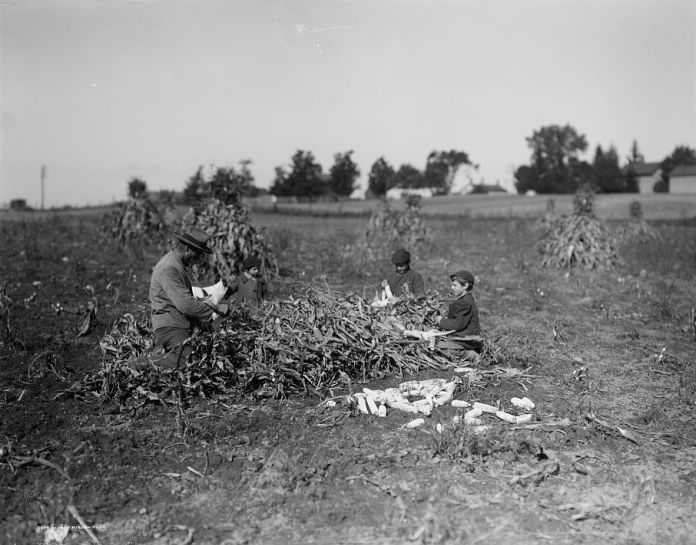Corn on the western Pennsylvania farm of my youth was all cut, shocked and husked by hand until probably the fall of 1947.
That year, Dad hired a neighbor who had an Allis-Chalmers WC tractor with a two-row mounted corn picker. That particular A-C picker model used a pair of combined snapping-husking rolls for each row, one rubber and one steel with rubber button inserts. These eliminated a lot of moving parts and worked well on damp husks but not so well when the corn was dry.
1947 must have been a dry year because I recall Dad being upset because some husks were left on the ears.
Of course, mechanical corn pickers had been in use for several decades prior to my conservative father trying them, although in Dad’s defense, our small corn acreage of 20 to 25 acres hardly justified a picker and as all the neighboring farmers also husked by hand, there was no one to hire to do the job.
New machines
During the 1920s, the pros and cons of the new-fangled machines were hotly debated in the farm press. An article in the October, 1926, issue of The American Thresherman, gave the following figures for two huskers with the average wage of 7 cents per bushel plus room and board.
The two men with one wagon would take 33 1/3 days to husk 100 acres of 50-bushel-per-acre corn. The cost was figured to be 5,000 bushels at 7 cents, $350; team at $4 per day, $133.34; wagon at 50 cents per day, $16.66; and board for two men at $1 per day each, $66.66, for a grand total cost to husk the 100 acres of $566.66.
They figured that a horse-drawn mechanical picker traveling at about 2 mph for a 10-hour day, would cover seven acres per day. Using, however a more conservative figure of six acres per day, it would pick and husk 300 bushels each day and would need seven horses, two wagons, and two men, and would take but 16 2/3 days.
They calculated the seven horses at $2 per day each, $233.34; two wagons at 50 cents per day each, $16.66; and two men at $5 per day each, $83.33, for a total of $333.33 and a savings of $233.33 overhand husking.
This saving was claimed to be more than enough to pay for the machine in two years. Letters from satisfied users maintained that the mechanical picker-husker saved time, money and field labor while relieving their wives of much cooking and washing for hired help.
Proven example
One Iowa farmer wrote, “I’ve been asked about my corn picker and I like it fine. Anyone who has to hire men to pick corn should not be without a picker, as they pay for themselves in one or two years.
“I used horses on it at first and picked five to seven acres a day. After getting the tractor, I could do about three more acres in the same number of hours.” He went on, “I don’t think it leaves any more corn than the average man and gets the small ears that are usually left by the average man, and it cleans the ear of practically all the husks and silk.
The following April, a Minnesota farmer wrote in dissent, “I don’t think that hand picking was given a fair deal. In 1925, the machine lost as high as 229 ears on one 80-rod row; just figure the loss when it takes about nine rows to an acre.
I have observed closely the difference in the two methods and am satisfied that the waste would pay for the corn husked by hand, besides saving the cost of operating the machine, including interest and depreciation, and the corn stalks would be left in much better condition for fodder.
Wasteful method
In my estimation, mechanical corn husking is a very wasteful method and is to some extent the reason for the present condition of agriculture. Then again, in the October, 1927, issue, The American Thresherman again extolled the advantages of mechanical picking while acknowledging the contrary views of the Minnesota man.
A survey of 100 farmers in the Dakotas who were using mechanical pickers found that much hard labor can be saved by their use; however, the average minimum corn acreage to justify buying a picker was said to be 63 acres, while the maximum acreage for one machine to handle was 197.
The average life of a picker was ten years, while the first cost was $400 to $425 without a PTO attachment, which adds about $100.
The amount of corn husked per man per day with a picker was from 69 to 102 bushels, a difference of 10 to 43 bushels per day in favor of the corn picker, and when a tractor was pulling the machine the difference was even greater.
The survey found that while the farmer with a small corn acreage can’t afford such a machine for his own use due to the large investment, two or more such farmers might do well to consider buying a picker jointly.
So the argument went on, but as the years went by more and more corn farmers adopted the corn picker and today hand husking of corn is a mostly forgotten art. The staccato sound of ears hitting a wagon’s bang board are a thing of the past, except at the few hand husking demonstrations held around the country.













